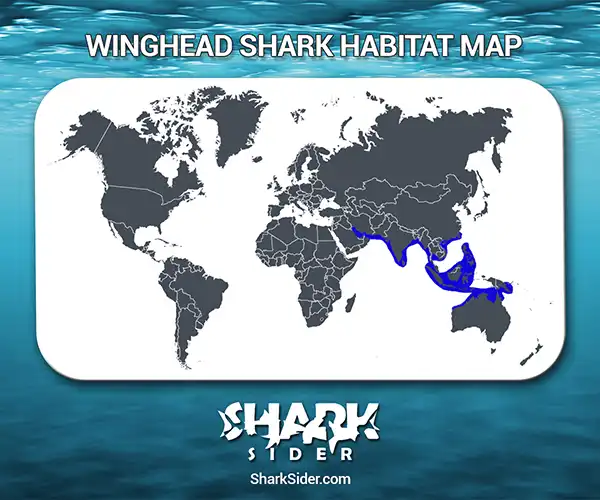The winghead shark is a hammerhead shark that earns its name from its unique-looking cephalofoil. This “hammer” is almost as wide as half the length of the shark’s entire body and looks like two wings on the top of its head.
Winghead Shark Scientific Classification |
|
| Kingdom | Animalia |
| Phylum | Chordata |
| Class | Chondrichthyes |
| Order | Carcharhiniformes |
| Family | Sphyrnidae |
| Genus | Eusphyra |
| Scientific Name | E. blochii |
Description
The most distinct feature of this shark is the shape of its cephalofoil or “hammer”, which consists of two wing-like segments that, combined, are 40-50% of its total body length. There are several indentations on the cephalofoil – including one in the middle and two on both nostrils. Both eyes are on either side of the head, and the nostrils are twice as long as their mouth.
Speaking of which, the winghead has a small mouth with 15-16 rows on the upper jaw and 14 on the lower one. Each tooth is small and triangular, with smooth edges.
Reaching lengths of 6.2 ft, these sharks have streamlined bodies with a sickle-shaped first dorsal fin. The second dorsal fin is on the opposite side of the shark’s body from where the anal fin is located. Their skin is covered with dermal denticles.
Winghead sharks are brownish gray from above and off-white from below.
Where do they live
Map Of The Winghead Shark’s Habitat

The range of these sharks is from the Persian Gulf to New Guinea and northern Queensland, throughout the central and western Indo-Pacific Ocean. They inhabit shallow waters, often entering bays and estuaries.
Behavior
Hunting
Their diet consists of bony fish, cephalopods, and crustaceans. They forage on the bottom of the ocean floor for prey.
Reproductive
These sharks are viviparous, giving live birth to a litter of 6-25 pups annually after a gestation period ranging from 8 to 11 months. Females can mate annually and are known to bicker with themselves when pregnant.
The embryo feeds on the yolk of their egg sac, slowly developing into a smaller version of an adult shark, though with crude features and lacking the coloration of their older counterparts. When they are born, they are around 13-19 inches long. At about 7 years, they become sexually mature, males being 3.3–3.6 ft long and females 3.6–3.9 ft.
On average, a winghead shark lives for 21 years.
Adaptations
There are several hypotheses about why this shark has such a unique hammerhead. Firstly, the presence of each eye on either end of the cephalofoil gives them excellent depth perception and a wide range of vision. Secondly, their nostrils are long and spread apart, with more chemical receptors, letting them isolate certain smells and track them in the direction they came from. And finally, the larger cephalofoil gives their ampullae of Lorenzini a large surface area to detect the electric fields of their prey.
Interactions with humans
This shark is not known to bite humans and isn’t very dangerous. However, human activities have taken a profound toll on this shark’s population. They are captured for their fins to make shark fin soup, their liver for the vitamin oil generated, and the rest is processed into fishmeal. These fishing activities have caused such a steep decline the IUCN declared the whitehead shark “Endangered” or “EN”. The only exception seems to be in Australia, where it is classified as “Least Concern” or “LC” due to it not being overfished there.
